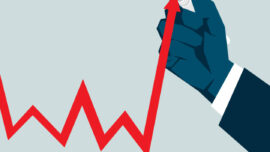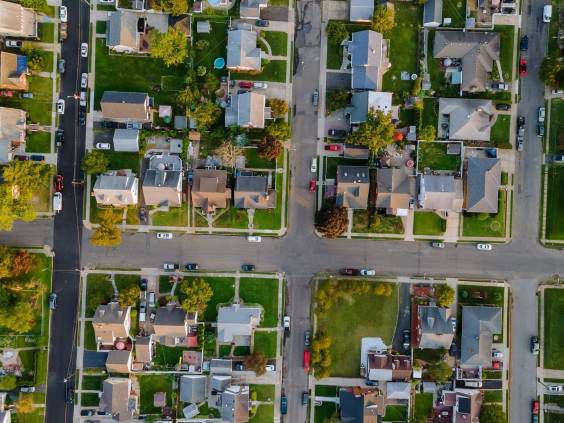Mortgage costs are less than rate of inflation for first time in 40 years

Nobody likes to spend more for their daily expenses, so last week’s news of the 3.7% inflation rate was not well received. According to Statistics Canada, it was the largest annual spike since October 1987.
A lot of attention has been paid to the rising costs of food or used cars, as well as in stocks and speculative assets. But Canadians, being as obsessed as anyone with real estate, also zeroed in on the fact that, for the first time in over 40 years, the cost to carry a mortgage was less than the rate of inflation.
“If you follow basic economic logic, then now is the time to get a mortgage,” explained a mortgage broker.
Buyers can get a variable-rate mortgage for 1.15% — about 1/3 of current inflation rates, he explains further. For those looking for a bit more security, the median discounted rate on a five-year fixed mortgage is 2.45% — 125 basis points lower than the current inflation rate.
At these rates, a borrower can finance the purchase of a high-value asset at a rate that’s 1/3 to 2/3 lower than inflation and, even if this asset only appreciates at the rate of inflation, you’re still ahead, he adds.
But there’s no such thing as a free lunch, just ask anyone who can remember the inflation and double-digit interest rates of the 1970s. And while the current economic situation isn’t the same as it was in the 1970s, there are worrisome similarities.
For instance, the coronavirus created a need for massive government spending. This response drove up the cost of goods, because it flooded the marketplace with cheap, accessible money, even when earnings didn’t keep up. To dampen inflation, monetary policy can raise overnight rates — making it more expensive to borrow and, in theory, slowing down the rate of growth.
It’s also why mortgage experts and financial planners caution about the potential for rates to rise, with forecasts calling for the median five-year fixed mortgage rate to increase almost 300 basis points to 2.73% by the end of 2021 and crack the 3% mark in 2022.
“In a world where rates are rising, we can’t keep going down for eternity,” he continued. In fact, the majority of Canadians believe that ongoing historic lows for mortgage rates, while making mortgages cheaper to carry, are actually having a net negative effect on the affordability of housing. They are actually helping to inflate the bubble.

This is particularly true given a recently published study by macroeconomists Jonathon Hazell, Juan Herreño, Emi Nakamura and Jón Steinsson. By studying historical price increases, the economists found that demand-driven stimuli, such as flooding the market with easy money, were completely ineffective in curbing inflation. Raising interest rates, on the other hand, crushed inflation.
“There’s no need to panic to rush out and buy a home,” the broker adds. “The Bank of Canada won’t knowingly increase at a pace that will push the country towards bankruptcy.”
The Bank of Canada will eventually raise the overnight rate by 175 basis points but this increase will be slow and gradual, explains CIBC Capital Markets Chief Economist, Avery Shenfeld.
“We know the Bank of Canada and the U.S. Feds are prepared to live with the temporary pressures [of inflation] as the economy recovers,” says Shenfeld. “No one is in a hurry to snuff out the [economic] recovery.” Indications are that a sustained upswing in inflation is baked into the economy at this point, but central bankers are still holding to their forecasts that it will subside.
What should homeowners do?
The current ‘free money’ environment does offer opportunities. For instance, current borrowers should consider locking in at the lowest rate on their debt. For example, if a homeowner owes $400,000 on a mortgage and has a fixed-rate loan at 2.5%, and it would cost $5,000 to break the loan contract to get a new rate of 1.77%, then that homeowner could save more than $680 per month — or just over $40,000 in five years.
Borrowers with variable-rate mortgages will pay less to penalties — the equivalent of three months’ interest — and either save money or get a bit of a guarantee by locking in for the next five years with an ultra-low rate.
Key free-lunch strategies aren’t isolated to mortgage-holders. Borrowers should also consider:
- Refinancing loans
- Consolidating debt
- Transferring high-interest debt, such as credit card balances, to lower-interest loans
Even though it’s cheap to borrow, homeowners should avoid refinancing if the added debt does nothing to improve their overall balance sheet. For instance, refinancing to complete a basement suite, which will add a new revenue stream, would be a smart way to use low-interest debt. Refinancing to update your kitchen in a home you don’t intend to sell in the next five years may not be as wise.
What should homebuyers do?
“Tread carefully,” warns Toronto-based certified financial planner Jackie Porter. While the government and policymakers are all keen to keep the economy growing, rates can’t stay this low forever.
Buyers will need to realize that rising rates will reduce how much they can borrow and erode overall purchasing power, explains Porter. Rising rates will also add to their overall living costs.
Let’s assume you buy a home this year and negotiate a $500,000 mortgage with a 5-year fixed rate of 2.0%. Over the length of the loan term, you’ll pay just over $46,000 in interest. Wait until 2022, when median fixed rates are expected to rise to 3%, and you’ll end up paying just over $72,000 in interest, over the same period of time — a 56.5% increase in your finance costs.
It isn’t all bad news for buyers, explains Diana Petramala, senior economist at Ryerson University’s Centre for Urban Research and Land Development. While housing prices are incredibly high, tighter amortization regulations, the mortgage stress test and low rates help to shield both buyers and the overall economy from the impact of interest rate hikes.

“Low mortgage rates mean that more of your monthly mortgage payment goes towards paying down your principal debt. The less you owe, the less susceptible you are to a rate adjustment,” says Petramala.
Consider how the portion of the first mortgage payment has changed since the 1980s. Four decades ago, only 3.8% of a mortgage payment went to paying down the principal debt, according to the analysis done by Edge Analytics. This increased to 7.2% in the 1990s and 11% at the turn of the century and, these days, 16.2% of that initial mortgage payment goes to paying down the overall loan debt.
“Current low interest rates are helping households pay down more of their debt,” explains Petramala, and this makes them less vulnerable when rates finally do increase.
Still, those eager to get into the housing market during this easy money phase will need to do their due diligence:
- Don’t over-extend and buy at the top of your price range. If you over-extend just to get in then at the time of renewal, you could face housing costs that doubled or tripled, should mortgage rates continue to rise.
- Shop now for a pre-qualified mortgage rate and get the longest possible rate-lock guarantee that the lender is willing to offer — and get it in writing.
- Consider a fixed-rate mortgage, which will shelter your housing costs from inflationary pressures over the life of the term.
- Consider using pre-payments to repay the principal debt faster. Do this while rates are cheap and you could save yourself tens of thousands on interest payments over the life of the mortgage loan.

“A good rule of thumb is to determine if you could afford to make the payments based on the posted five-year fixed-rate,” says Porter.
Butler adds that this calculation is already factored into the house-buying decision since lenders must qualify all borrowers using the mortgage stress test.
“Eventually, there will be a reckoning,” says Butler. “It’s just tough to pick the day.”






